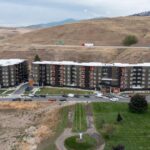On Sept. 15, dry pine needles littered the forest floor, forming a beige blanket over charred soil. Insect chatter echoed through the woods while a woodpecker pounded the trunk of a scorched Douglas fir, scattering chips of charcoal. In mid-July, when the Horse Gulch Fire burned at its most intense, firefighters cut a perimeter along the timberline’s edge, just beneath a ridge’s saddle. Now, a narrow lane of overturned soil, evidence of firefighting bulldozers, separated blackened earth from green grass. Verdant sprouts of assorted flora, none more than a foot tall, rose from the churned earth.
The Horse Gulch fire was first reported 10 weeks ago, on July 9. Through the latter half of July, the blaze smothered Helena with smoke as it burned more than 15,000 acres. Blackened grassland, scorched ponderosa pine and charred Douglas fir now decorate the burn scar just north of Canyon Ferry Lake.
Within their brief lifespans, wildfires bring dramatic changes to Montana’s forests and grasslands. But many of the most lasting effects on the landscape appear in the weeks, months and years after the flames are snuffed out. Justin Gude, a research and technical service section chief with the Montana Department of Fish, Wildlife & Parks, says wildfires are a fundamental part of the state’s natural history.
“Everything you see is the product of fire over the years,” Gude said.
…




